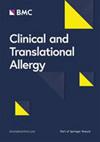Subcutaneous Allergen-Specific Immunotherapy for Allergic Rhinitis: Divergent IgA Responses in Nasal Mucosa and Blood With Validation of B Cell Class-Switching in Lymph Nodes and Blood
Abstract
Background
Subcutaneous immunotherapy (SCIT) has been a cornerstone treatment for allergic rhinitis (AR) for over 50 years, consistently demonstrating symptom reduction and modulation of immune responses. Despite this, the underlying mechanisms responsible for the efficacy of SCIT remain incompletely understood, especially with regard to local immune responses in lymph nodes and nasal mucosa.
Aim
To determine the impact of SCIT treatment on immunoglobulin production in blood and nasal mucosa, as well as B cell class-switching in blood and lymph nodes.
Methodology
Blood, nasal lavage (NAL), and fine-needle aspirates (FNA) of inguinal lymph nodes were collected from 23 patients with birch and/or timothy pollen-induced AR before and after SCIT updosing. General response to SCIT was evaluated with symptom and medication scores, as well as allergen-mediated activation of basophils. Allergen-specific IgE, IgA, IgG, and IgG4 were measured in blood and NAL via ELISA. B-cell class-switching was assessed in blood and FNAs by flow cytometry.
Results
AR symptoms, medication use, and basophil sensitivity to allergens was reduced after SCIT updosing. Interestingly, the plasma levels of allergen-specific IgA, IgG, and IgG4 increased after SCIT updosing, while the levels of allergen-specific IgE and IgA decreased in NAL at this timepoint. Moreover, these results were accompanied by an increase in conventional (IgD−CD27+) and unconventional (IgD−CD27−) memory B cells in blood and lymph nodes, respectively.
Conclusion
This study highlights the differential effects of SCIT on local and systemic immunity and identifies early immunological changes associated with treatment. However, confirmation of long-term tolerance will require extended follow-up, including in-season analyses. The local decrease in allergen-specific IgA in NAL, alongside a systemic increase in allergen-specific IgA and IgG4, underscores the importance of assessing both mucosal and systemic responses when evaluating SCIT efficacy.


 求助内容:
求助内容: 应助结果提醒方式:
应助结果提醒方式:


